- News
- City News
- gurgaon News
- Gurugram: Why inclusive footpaths are the way forward
Gurugram: Why inclusive footpaths are the way forward

File photo of Gurugram city
GURUGRAM: The city needs a clean, walkable network of pavements but not more of the same. Rethinking footpath designs to incorporate vending facilities, bus stops and other utilities like street light poles and a mechanism to oversee and maintain them is the only way to make them useful and durable, besides ensuring that all the public money that goes into it is not wasted.
There is recognition of this in the city’s mobility document itself. But so far, it hasn’t translated into visible change.

Gurugram needs a footpath network of 1,083 km, running along a road network of approximately 800 km, according to the Comprehensive Mobility Management Plan (CMMP) of the Gurugram Metropolitan Development Authority (GMDA) released in 2020. This itself will take some doing because proper footpath coverage is less than 30% at present.
The CMMP emphasised that simply creating a network of footpaths in the city would not be enough, pointing out the need to “integrate” multiple elements that gover nment agencies have failed to consider while making roads and footpaths.
“Well-planned footpaths provide continuous space for walking. They also support other activities such as street vending and waiting at bus stops without compromising pedestrian mobility. The success of a footpath depends on integrating multiple elements in a coherent design,” stated the CMMP.
Guidelines laid down by the Indian Road Congress ( I RC ) make the same points, stating that “informal commercial activities” are an “integral” part of the “footpath environment” in India, which has gone unacknowledged in Gurugram so far. “Pedestrians also need them (vendors) as they cater to their day-to-day needs… The informal sector has to be integrated into the overall design of the footpath facility by providing space for them to operate,” state the IRC guidelines.
Doing this, experts say, will also make driving a better experience because all other activity on a road would shift to the footpath, clearing up the carriageways for vehicles.
The CMMP has some ideas on this. It states that “dedicated space” needs to be provided for trees and utilities “away from the path of travel of pedestrians”, and where such spaces are not available, footpaths should be extended through a “bulb out — n extension that could take up a bit of the road space — to incorporate them.
The guidelines of the IRC similarly state, “The location of garbage bins, electric poles and other features like signages, etc., should be on one side of the footpath to give a clear walkway to pedestrians.” Getting the design right is half the battle, the other is maintaining footpaths. In the city, footpaths in many areas are broken or littered.
Rohit Baluja, president of the Institute of Road Traffic Education (IRTE), believes the long-term solution is a change in the thought process and focus of engineers who plan and build footpaths.
“The most important thing is that engineers have to lay special emphasis on pedestrians. Pedestrians should get priority over vehicles. The design of the footpath must be such that it is inviting for pedestrians. It should be continuous and if there is a break, there should be a wedge or a slope so that pedestrians do not have to climb or step down. If there is any construction on the footpath, engineers should ensure they give controlled access on the carriageway to pedestrians, by putting cones or making a portion of the footpath jut out so that people still have access,” says Baluja.
“Enforcement is critical as well. Today, there is no enforcement for the rights of a pedestrian anywhere.
There are laws dictating that people should not park their vehicles on the footpath and that nobody should drive on the footpath, but there is no enforcement,” he adds. Mukta Naik, fellow at the Centre for Policy Research, thinks the problem is not just with footpath design but with the attitude towards pedestrians, who are “not prioritised in any aspect of city planning”. The lack of pressure from pedestrians, she says, also plays a role in this. “There is no doubt that pavement infrastructure is fundamental to any city.
Poor design and bad construction violate standards, but the bigger problem is that there is no demand for it. Most pedestrians come from a segment of society that has a chiefly economic relationship with the city. They may not envisage living here longterm and so are not invested enough to put pressure on public authorities. Besides, there are hardly any effective political forums that can mobilise the working-class population and articulate their needs,” says Naik.
“As a result, pedestrians have no voice in influencing the government and public pressure is for car-centric infrastructure instead. One way to turn this around is by building a narrative on sustainability, by getting data we need to inform people what kind of street design is actually needed. The government needs to build the case for sustainable public infrastructure design for its citizens,” she says.
There is recognition of this in the city’s mobility document itself. But so far, it hasn’t translated into visible change.

Gurugram needs a footpath network of 1,083 km, running along a road network of approximately 800 km, according to the Comprehensive Mobility Management Plan (CMMP) of the Gurugram Metropolitan Development Authority (GMDA) released in 2020. This itself will take some doing because proper footpath coverage is less than 30% at present.
The CMMP emphasised that simply creating a network of footpaths in the city would not be enough, pointing out the need to “integrate” multiple elements that gover nment agencies have failed to consider while making roads and footpaths.
“Well-planned footpaths provide continuous space for walking. They also support other activities such as street vending and waiting at bus stops without compromising pedestrian mobility. The success of a footpath depends on integrating multiple elements in a coherent design,” stated the CMMP.
Guidelines laid down by the Indian Road Congress ( I RC ) make the same points, stating that “informal commercial activities” are an “integral” part of the “footpath environment” in India, which has gone unacknowledged in Gurugram so far. “Pedestrians also need them (vendors) as they cater to their day-to-day needs… The informal sector has to be integrated into the overall design of the footpath facility by providing space for them to operate,” state the IRC guidelines.
Doing this, experts say, will also make driving a better experience because all other activity on a road would shift to the footpath, clearing up the carriageways for vehicles.
The CMMP has some ideas on this. It states that “dedicated space” needs to be provided for trees and utilities “away from the path of travel of pedestrians”, and where such spaces are not available, footpaths should be extended through a “bulb out — n extension that could take up a bit of the road space — to incorporate them.
The guidelines of the IRC similarly state, “The location of garbage bins, electric poles and other features like signages, etc., should be on one side of the footpath to give a clear walkway to pedestrians.” Getting the design right is half the battle, the other is maintaining footpaths. In the city, footpaths in many areas are broken or littered.
Rohit Baluja, president of the Institute of Road Traffic Education (IRTE), believes the long-term solution is a change in the thought process and focus of engineers who plan and build footpaths.
“The most important thing is that engineers have to lay special emphasis on pedestrians. Pedestrians should get priority over vehicles. The design of the footpath must be such that it is inviting for pedestrians. It should be continuous and if there is a break, there should be a wedge or a slope so that pedestrians do not have to climb or step down. If there is any construction on the footpath, engineers should ensure they give controlled access on the carriageway to pedestrians, by putting cones or making a portion of the footpath jut out so that people still have access,” says Baluja.
“Enforcement is critical as well. Today, there is no enforcement for the rights of a pedestrian anywhere.
There are laws dictating that people should not park their vehicles on the footpath and that nobody should drive on the footpath, but there is no enforcement,” he adds. Mukta Naik, fellow at the Centre for Policy Research, thinks the problem is not just with footpath design but with the attitude towards pedestrians, who are “not prioritised in any aspect of city planning”. The lack of pressure from pedestrians, she says, also plays a role in this. “There is no doubt that pavement infrastructure is fundamental to any city.
Poor design and bad construction violate standards, but the bigger problem is that there is no demand for it. Most pedestrians come from a segment of society that has a chiefly economic relationship with the city. They may not envisage living here longterm and so are not invested enough to put pressure on public authorities. Besides, there are hardly any effective political forums that can mobilise the working-class population and articulate their needs,” says Naik.
“As a result, pedestrians have no voice in influencing the government and public pressure is for car-centric infrastructure instead. One way to turn this around is by building a narrative on sustainability, by getting data we need to inform people what kind of street design is actually needed. The government needs to build the case for sustainable public infrastructure design for its citizens,” she says.
FOLLOW US ON SOCIAL MEDIA
FacebookTwitterInstagramKOO APPYOUTUBE
Start a Conversation
end of article









